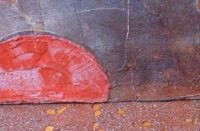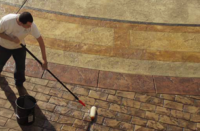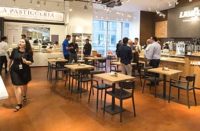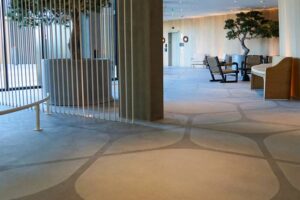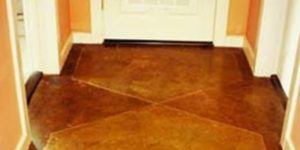
 Texas artisan Shellie Rigsby, owner of Acanthus Inc., knows as much as anyone about using decorative concrete for artistic expression. So when she took charge of installing a decorative concrete floor at a new youth recreation center, she invited young people to put their own stamp on the place.
Texas artisan Shellie Rigsby, owner of Acanthus Inc., knows as much as anyone about using decorative concrete for artistic expression. So when she took charge of installing a decorative concrete floor at a new youth recreation center, she invited young people to put their own stamp on the place.
The center, called “The Warehouse,” is part of a new campus built for Seabreeze Church in Huntington Beach, Calif. As one might expect from its name, The Warehouse generally sports an industrial look inside and out, but Rigsby has designed and installed flooring and other decorative concrete effects at the site. Legacy Decorative Concrete Systems Inc., a subsidiary of Solomon Colors, supplied materials, including microtoppings, stains and stencils.
Rigsby wanted a walk across the youth center floor to be like an ocean-side treasure hunt. “Because this is a beach community, the theme of this room is a walk on a beach,” she says. “It’s not limited to that, but that’s the theme of it.”
 She involved young people from the city and the church community every step of the way. First, she asked them to submit drawings and designs for the floor. “I gave them no restrictions except that they had to draw normal creatures — no dragons or aliens.”
She involved young people from the city and the church community every step of the way. First, she asked them to submit drawings and designs for the floor. “I gave them no restrictions except that they had to draw normal creatures — no dragons or aliens.”
Then Rigsby went to work. She scanned and resized the pictures, then printed them ontoalow-tack adhesive film so they could be stenciled onto the floor. In some cases, she would apply a gel resist over the stencil film, then pull up the stencil, apply a stain, and finally remove the dried gel. In others, concrete engraving tools were used to cut images into the concrete. Acid stain, water-based stain, microtoppings, and other decorative concrete media were layered over one another. Some patterns stand out, and some patterns are pressed in.
 She also provided water-based stains, pigments, sealers and engraving equipment for the kids and turned them loose, letting them detail many of the images themselves. She even asked them to come up with words, phrases and sentences that fit the ambience of the church youth center. She createdmultiple fonts for Legacy to cut into stencils, then interspersed the words among the designs. The final effect is a floor that is dense with images and ideas. “It’s very much like graphic design on steroids in concrete,” she says.
She also provided water-based stains, pigments, sealers and engraving equipment for the kids and turned them loose, letting them detail many of the images themselves. She even asked them to come up with words, phrases and sentences that fit the ambience of the church youth center. She createdmultiple fonts for Legacy to cut into stencils, then interspersed the words among the designs. The final effect is a floor that is dense with images and ideas. “It’s very much like graphic design on steroids in concrete,” she says.
One of the visual centerpieces of the floor is a 10-foot “Woody Wagon” based on a drawing submitted by Krista Winburn, one of the young artists. To deck out the wagon with chrome, Rigsby used Modern Masters Metal Effects. “It looks like I took polished metal and embedded it in the concrete,” she says. “It’s very compelling.”
Another young artist’s picture looked vaguely like a license plate, she says, so she incorporated that into the wagon design as well.
 In one corner of the room is a “sun,” a 13-foot quarter circle outlined by an 8-inch wide band of embedded lights. Rigsby cut a trench into the concrete so an electrician could embed the lights. Then the trench was backfilled with pigmented epoxy.
In one corner of the room is a “sun,” a 13-foot quarter circle outlined by an 8-inch wide band of embedded lights. Rigsby cut a trench into the concrete so an electrician could embed the lights. Then the trench was backfilled with pigmented epoxy.
No beach is complete without the ocean, and a 10-foot wave near the Woody was installed by Randy Klassen, a decorative concrete contractor from Canada who lent his expertise to the Seabreeze job.
Rigsby and her skills in decorative concrete have come in handy in other parts of the project too. She recommended finishes and design touches for the walls and built-in furniture at The Warehouse, including the idea of using galvanized metal for countertops and shelving, supported by metal pipes and flange.
She installed a more traditional concrete stain on a floor in a multipurpose room adjoining the Warehouse room. Together, the two floors total 4,500 square feet. She’s also helping outdoors. The church is being constructed on the site of a former tennis club, and the top hard layer of the tennis court area has been blasted off to expose the concrete beneath. The old concrete has been cut and trimmed into an oval crossed with rays, and Rigsby has provided the finishing touch: staining the oval amber with hickory accents.
 Rigsby’s decorative philosophy of starting with the design and working backward came in handy at the Warehouse. “In a residential setting, the intensity of this design would overwhelm the space — this would be unappealing and inappropriate,” she observes. “The floors should cohesively compliment and serve the comprehensive design. If you overdesign a space, you fail to have regard for the best interest of the space. You can design something in keeping with and consistent with the whole property, the whole space.”
Rigsby’s decorative philosophy of starting with the design and working backward came in handy at the Warehouse. “In a residential setting, the intensity of this design would overwhelm the space — this would be unappealing and inappropriate,” she observes. “The floors should cohesively compliment and serve the comprehensive design. If you overdesign a space, you fail to have regard for the best interest of the space. You can design something in keeping with and consistent with the whole property, the whole space.”
But more than Rigsby’s philosophies, the Warehouse floor expresses the voices of the young people of Huntington Beach. The kids who worked alongside Rigsby can even put designing a commercial decorative concrete floor on their college applications, she notes. “They have put their mark on their space. It embodies them. It represents who they are as a community.”
